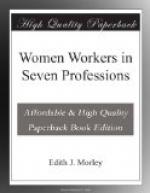It is important to remember this fact, when considering the present and future prospects of the midwife. The untrained woman used to charge 5s. or 7s. 6d. for her services, and the fact that her name had been enrolled on the Government Register, that she was subject to the supervision of an inspector, without having spent anything on her change of status beyond the 10s. registration fee, did not suggest the need of any particular change in her scale of charges. Thus 7s. 6d. per case, unfortunately still remains the very common fee for midwifery, though this now involves, under the rules of the Midwives’ Board, not only the long hours of watchful care at the birth, but ten days of daily visits to supervise both mother and baby, with careful records of pulse and temperature, etc., kept in a register. Naturally, the general public who employ midwives—viz., the poorer classes—do not differentiate between the trained certificated midwife and the untrained bona-fide midwife whose name is on the register, and thus the scale of charges remains very low and the profession, as one for educated women, is thereby greatly injured.
Granted an intelligent woman is willing to give six months’ work and study and L35 to L40 for her training, what chance has she of earning a decent living? If she could command 15s. or 17s. 6d. per case afterwards, she could make a decent living, given fairly hard work and the acceptance of real responsibility. If she had 100 cases a year, she would earn L75 at 15s. per case, and so on. This rise in the fees payable to midwives has just been made possible by the National Insurance Act of 1911, the framers of which appear to have recognised the necessary result of the Midwives’ Act of 1902. As the bona-fide midwife, who has received no training, gradually dies out, it becomes necessary to provide the means of paying trained midwives, whom the people are obliged to employ in place of the old ones, but who would soon be non-existent were the means of paying them not also provided by the State.
A 30s. maternity benefit is now given for every confinement of an insured person or the wife of an insured person. As the patient may have free choice of doctor or midwife, it seems possible, now that it has been established that the benefit shall go direct to the mother or her nominee, that hereafter the greater part of it may be paid over to the person who can supply that most necessary item of the treatment, i.e., good and intelligent midwifery with nursing care of mother and child. Therefore, it is the right moment for the careful, well-trained popular midwife definitely to raise her fees to all “insured” patients, being still willing to help the poor at a low fee as before. It should be remembered that in about one-tenth of all her cases, medical help will be required, but this case could probably be guarded against by an insurance fund, if properly organised.
We frankly admit that as things now stand—apart from the possibility of the maternity benefit being made to help her—midwifery is financially but a poor profession. But to an enthusiastic lover of her kind, who has other means or prospects for her future than the proceeds of her profession, there is much that is attractive in this most useful calling.




